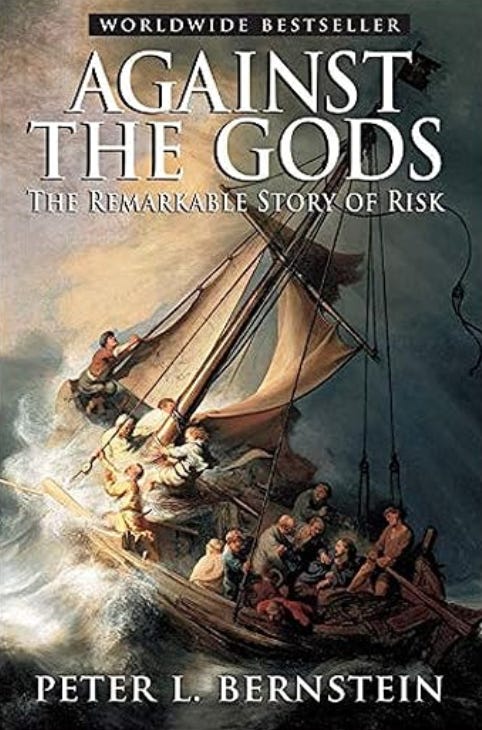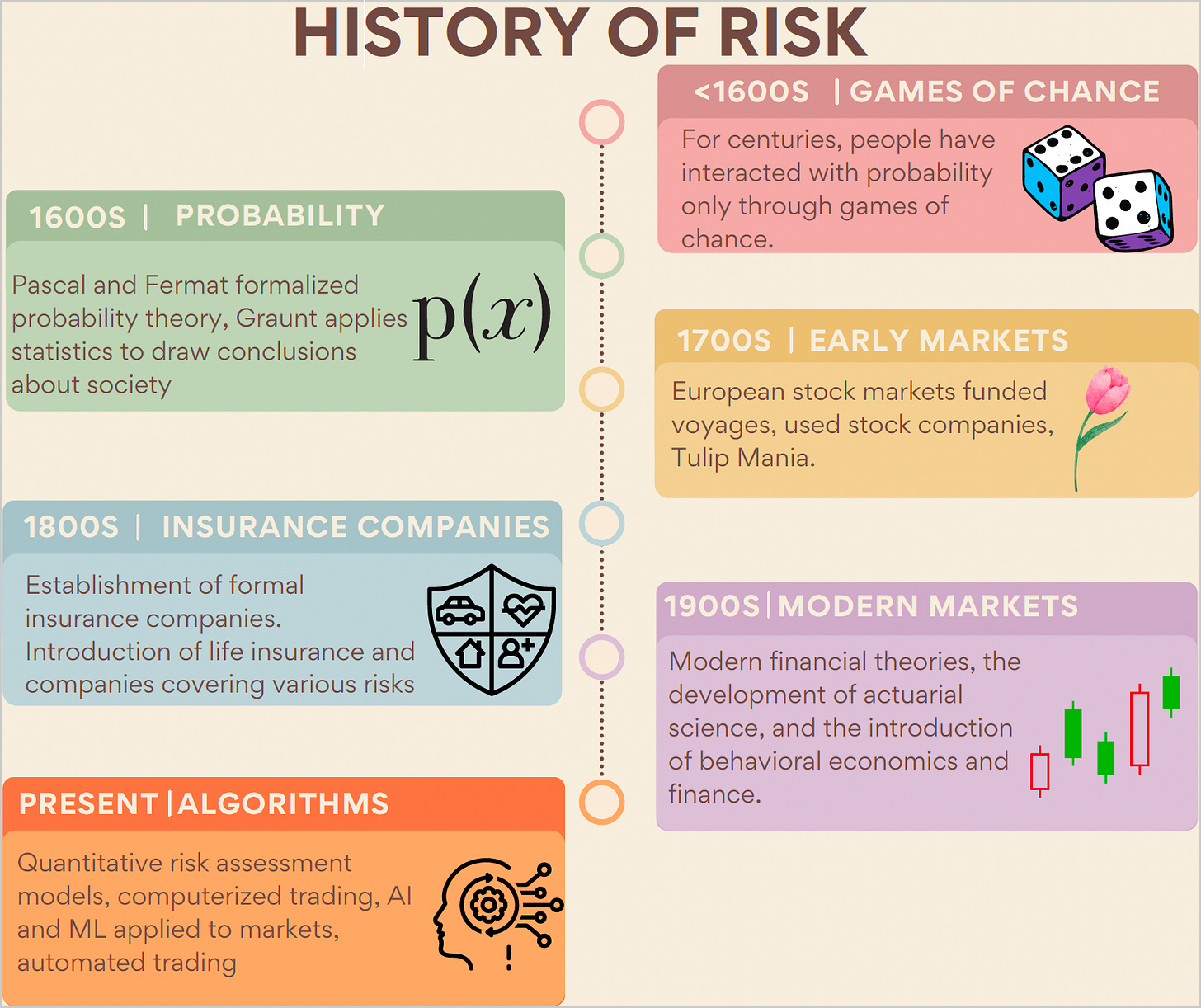Book Review: 'Against The Gods' by Peter L. Bernstein
Five diverse opinions on 'Against The Gods' by Peter L. Bernstein
Summary: The story of a culture and their mathematics are intertwined
Review: 5 reviewers, 5 opinions
Conclusion: Who is this book for?
Book Club is a place where five friends get together and discuss some books. In this post, I will give some of our perspectives on our most recent read, Against The Gods: The Remarkable Story of Risk, By Peter L. Bernstein.
I am writing this review to give a short summary and our individual thoughts. Why is this review interesting? We each felt differently about whether the concepts in this book could be applied based on our interests, occupations and our relationship to theory or practicality. Probably the most interesting discussion to come of this book is the meta-narrative: when do books like these cross from theory to utility? The answer: It’s in the eye of the beholder.
1. Summary
The Author: Peter L. Bernstein was an educator, investor and writer who popularized the Efficient-Market Hypothesis, which states that asset prices in the market reflect all available information and are therefore impossible to predict. This simple idea and its counter-arguments encapsulate hundreds of years of understanding of mathematics and cross the boundary between ego and decision making…can you beat the house?
His most famous works came within the last 20 years of his life, including Against the Gods. By all accounts Mr. Bernstein was a consummate educator, and believed in the dissemination of free education, a mission he practised via his public outreach. He wrote a widely-read newsletter, which he would update until his death at the age of 90.
Ancient Understanding of Risk:
Bernstein opens with the history of probability. This march through time could be best posed via a series of questions. For instance, did the bible have anything to say on risk? Why didn’t Roman numerals and alphanumeric systems lend themselves to calculation? Most interestingly, why didn’t the Greeks, masters of logic, conceive of risk? In answering this last question, for instance, he takes the reader across the boundaries of logic, religion and belief. On the logic side, Ancient Greek truth lay in proof and identity. Think platonic ideals, The allegory of the Cave, the Archetype, mathematical identities, 1=1 → True, etc..
Amazingly, Ancient Greek beliefs also prevented the use of Probabilities. Games of chance were not chance at all; a roll the Astragali places you at the mercy of The Fates. Probabilities were in direct conflict with the certainty offered by the pantheon. All fickleness on terra firma was a direct result of the fickleness of the pantheon, which could not be predicted. In this explanation, Bernstein builds our understanding of ancient logic from the ground up. He re-creates the environment under which proofs were born giving the reader a glimpse into the relationship between belief and logic.
Bernstein expertly weaves a meta-narrative on the relationship between belief and practical application. For instance, technical limitations of ancient alphanumeric (numerology) or Roman numbering systems impeded transaction. As a result, European intellectuals were in the dark on mathematics for hundreds of years, ending only after “exchanges” with Arabic intellectuals during the Crusades.
One main limitation of this book is its complexity. A first pass of this book is not sufficient to grasp the nuances of the subject if you’re a beginner. So, to ground my understanding, I generated the following very simple map.
Bernstein builds the context surrounding ancient mathematics using expertly-lain bricks of text, taking the reader through the environments which gave rise to the links between logic and belief (almost a numerical version of the Sapir-Whorf.)
Probability After the Enlightenment:
I am cutting Bernstein’s analyses on the evolution of probability theory woefully short. Bernstein details the circumstances which enabled great thinkers, such as Cardano, Bernouille, Pascal, Bayes which gave rise to their seminal works. He takes the listener on a journey from inspirations of the era, such as theories on the evolution from Darwin, to their applications, like Galton’s regression to the mean and the law of large numbers.
Modern Applications of Probability:
He details the eternal struggle between proponents of the idea that humans are rational actors, exemplified by Oppenheimer’s Game Theory, and their counter arguments, as seen in Khaneman and Twersky’s Prospect theory. Despite the value of the question, he ultimately rends this answer moot; for the preceding 300 years of exploration on probability yielded composite models such as the Central Limit Theorem and the simple yet brilliant Markowitz Diversification Theory. These seminal models encompassed the decisions made by both rational and irrational actors; mathematical representations of the human condition. Bernstein ends with Futures, Derivatives and Options and recounts the emergence of technology-based trading as it was in 1996 (Note: My weakest section, so I must re-read for more commentary).
2. Our Reviews:
Positives
Daren: 4/5. The history of risk is well written. I love this book for grounding my understanding of risk and probability. As a scientist I frequently would have to ask “what model am I using to represent the reality of the science I am looking at? Are the factors which determine protein interactions random? Is there an exponential effect or linear effect at play? and so on. By tracking the development of risk from the ground up, it helped me contextualize exactly what we mean when we say something is random1.
Laurent: 3.8/5. The concept he found most critical and the one that made him think the most is that of the average man. In the book, Quetelet and others develop the idea of the Average Man, or L’homme Moyen, and the policy-making of many societies in the West has been founded on this man ever since. Laurent, as a medical doctor, is forced to understand medicine from this average man’s standpoint and it causes problems. We don’t yet have personalized medicine, so guiding people from their unique case toward the average man is only a guideline, and is never the goal. The average man is a figment of our collective imagination. To a practising doctor not only does this man not exist, but can be a dangerous standard.
Negatives
Dylan, Cedric, Zach: 2.5/5. Perspectives from Finance guys. Zach has a background in finance and was interested in the history, in particular how theories have taken shape and resulted in modern finance. He was particularly interested in modern applications, like derivatives, how companies buy and sell risk on oil prices, etc. For example, how does buying and selling the exact same risk reduce volatility in the transport sector and therefore the entire market? Dylan and Cedric: Also finance guys, the latter being an ex-lawyer currently pricing real-estate markets.
The greatest criticism was on the applicability and complexity of the book. They lost interest when Bernstein went into the details of statistical sampling and mathematics. They preferred the anecdotal aspects of the book, or the least applicable parts because this aspect of narration was purely for entertainment. Ideally, they would have preferred simplifications of the concepts, or their complete removal. Occasionally, Bernstein would warn the reader to skip a section when it got too technical. More of this would have been useful. In sum, the finance boys felt that this type of book falls into the middle ground between theory and application. It was not relatable enough and should have stuck to narration as its main mode of explanation.
3. Conclusion: Who is this Book For?
I would recommend this book for those who want to contextualize their understanding of mathematics and applied statistics. For me, it was “almost” to probability theory as Khaneman was to Decision Theory, or as Sapiens was to history. The first half on the history of the development of modern statistics is beautifully written and grounded in fascinating narratives.
I would not suggest this book for those who wanted a personal understanding of finance or immediately applicable advice. While you certainly can derive many lessons, you would need to do that extra application work on your own. Overall, this book was a fun and highly informative read, which grounded my understanding of probability. If you are interested in the understanding of math and history, then this book is for you.
Please subscribe, comment and share this review. If you hate it or disagree, why? ALL FEEDBACK IS WELCOME.
Thank you for reading.
~D
Most importantly, the theory in the book was grounded in interesting stories. I liked that it challenged my idea of where theory comes from – I took for granted that variation exists. In this book he indicated the environment which let me derive the whole variability of the world from series of binaries. This then led to understanding of modern portfolio theory and why diversification works. My previous understanding and risk was grounded in nothing really – I didn’t know why the law of large numbers worked.




